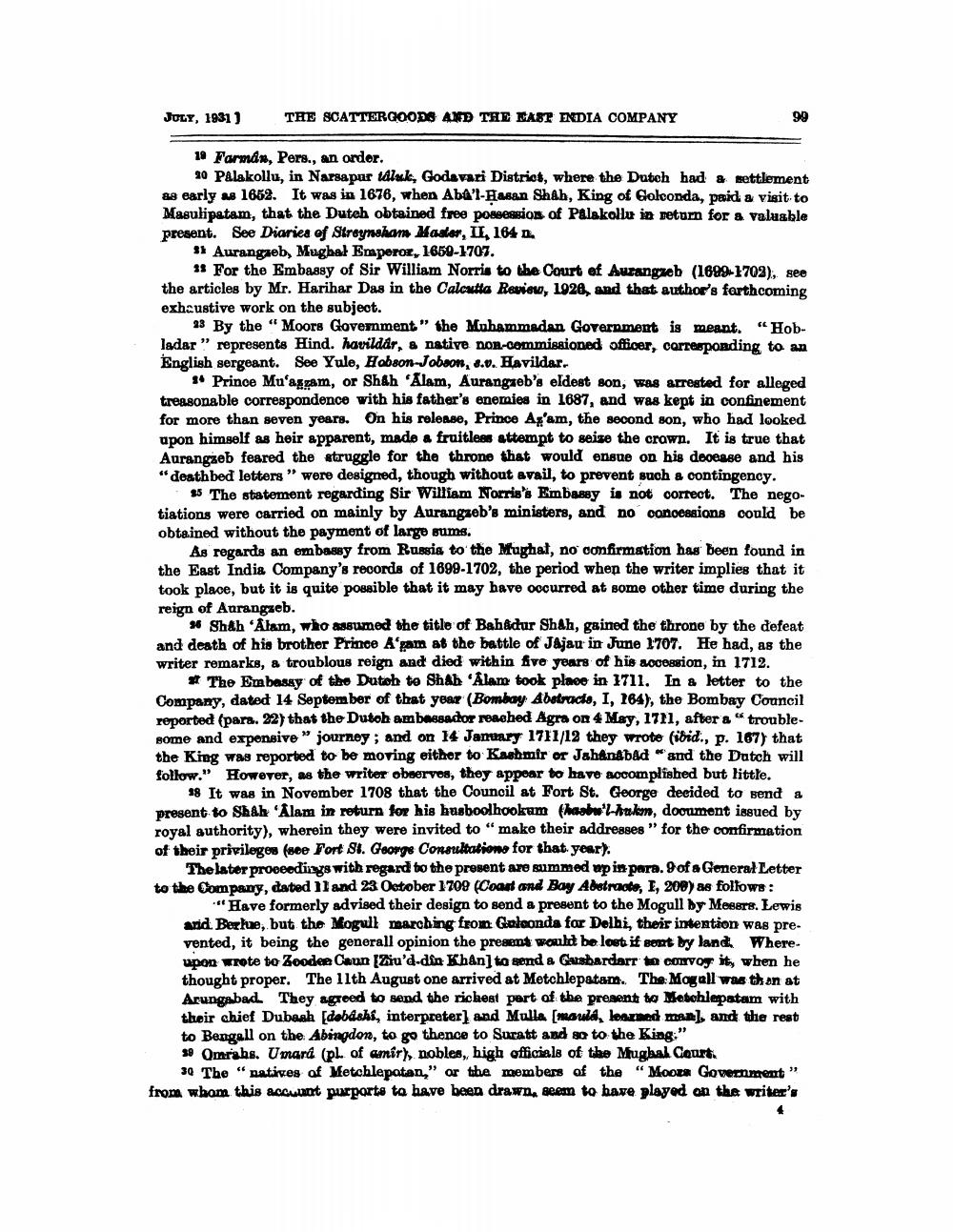________________
JULY, 1931)
THE SCATTERGOODS AND THE EAST ENDIA COMPANY
18 Farman, Pers., an order.
20 Palakollu, in Narsapar idial, Godavari District, where the Dutch had & settlement as early as 1652. It was in 1676, when Abi'l-Hasan Shah, King of Goloonda, paid a visit to Masulipatam, that the Dutch obtained free possession of Palakollu in return for a valuable present. See Diariea of Streynsham Maslar, II, 164 n.
31 Aurangzeb, Mughal Emperor, 1659-1707.
18 For the Embassy of Sir William Norris to the Court of Aurangzeb (1699-1709), see the articles by Mr. Harihar Das in the Calcutta Review, 1926, and that author's farthcoming exhaustive work on the subject.
13 By the "Moors Government." the Muhammadan Government is meant. “Hobladar” represents Hind. havildar, & native non-commissioned officer, corresponding to an English sergeant. See Yule, Hobson-Jobson, 8.0. Havildar.
9. Prince Mu'agzam, or Shah 'Alam, Aurangzeb's eldest son, was arrested for alleged treasonable correspondence with his father's enemies in 1687, and was kept in confinement for more than seven years. On his release, Prince As'am, the second son, who had looked upon himself as heir apparent, made a fruitlees attempt to seise the crown. It is true that Aurangzeb feared the struggle for the throne that would ensue on his decease and his “deathbed letters" were designed, though without avail, to prevent such a contingency.
95 The statement regarding Sir William Norris's Embassy is not correct. The negotiations were carried on mainly by Aurangzeb's ministers, and no concessions could be obtained without the payment of large sums.
As regards an embassy from Russia to the Mughal, no confirmation has been found in the East India Company's records of 1699-1702, the period when the writer implies that it took place, but it is quite possible that it may have occurred at some other time during the reign of Aurangzeb.
** Shah Alam, who assumed the title of Bah&dur Shah, gained the throne by the defeat and death of his brother Prince Afgam at the battle of Jajau in June 1707. He had, as the writer remarks, a troublous reign and died within five years of his accession, in 1712.
# The Embassy of the Dutoh to Shah Alam took place in 1711. In & letter to the Company, dated 14 September of that year (Bombay Abstracto, I, 164), the Bombay Council reported (para. 22) that the Dutoh ambassador reached Agra on 4 May, 1771, after a "troublesome and expensive ” journey; and on 14 January 1711/12 they wrote (ibid., p. 167) that the King was reported to be moving either to Kashmir or Jahandbad and the Dutch will follow." However, as the writer obeerves, they appear to have accomplished but little.
18 It was in November 1708 that the Council at Fort St. George decided to send a present to Shah Alam in return for his husboolhookum (hasbu'l-hakm, dooument issued by royal authority), wherein they were invited to "make their addresses " for the confirmation of their privileges (see Fort St. George Consultations for that year).
The later proceedings with regard to the present are summed up in pera. 9 of a General Letter to the Company, dated 11 and 23 October 1709 (Coast and Bay Abstracte, I, 200) as follows:
." Have formerly advised their design to send a present to the Mogull by Meeere. Lewis arid. Bertue, but the Mogul marching from Galaonda for Delhi, their intention was prevented, it being the generall opinion the present would be lost it sent by land. Where. upon wrote to Wooden Caun (Ziu'd-din Khan] to send a Gasbardarr to convoy it, when he thought proper. The 11th August one arrived at Metchlepatan. The Mogall was thon at Arungabad. They agreed to send the richest part of the present to Metohlepatam with their chief Dubash [dabashi, interpreter) and Mulla mauld, laxmed man), and the rest to Bengall on the Abingdon, to go thence to Suratt and go to the King:" 39 Omrahs. Umard (plof amir), nobles, high officials of the Mughal Court
39 The "natives of Metchlepatan," or the members of the "Moore Government" from whom this accuunt purports to have been drawn. seem to have played on the writer's




